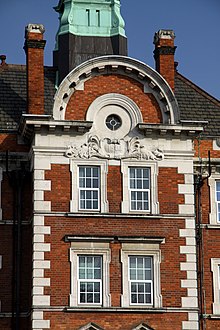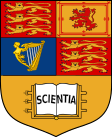Hammersmith Hospital
| Hammersmith Hospital | |
|---|---|
| Imperial College Healthcare NHS Trust | |
 Hammersmith Hospital in 2013 | |
 | |
| Geography | |
| Location | Acton, London, England, United Kingdom |
| Organisation | |
| Care system | Public NHS |
| Type | Teaching |
| Affiliated university | Imperial College London |
| Services | |
| Emergency department | No Accident & Emergency |
| Beds | 349 |
| History | |
| Opened | 1912[citation needed] |
| Links | |
| Website | http://www.imperial.nhs.uk/hammersmith |
| Lists | Hospitals in England |
Hammersmith Hospital, formerly the Military Orthopaedic Hospital, and later the Special Surgical Hospital, is a major teaching hospital in west London. It is part of Imperial College Healthcare NHS Trust in the London Borough of Hammersmith and Fulham, and is associated with the Imperial College Faculty of Medicine. Confusingly the hospital is not in Hammersmith at all but is located north of White City adjacent to Wormwood Scrubs and East Acton, rather than in Hammersmith itself.
Origins
Its origins begin in 1902, when the Hammersmith Poor Law Guardians decided to erect a new workhouse and infirmary on a 14-acre (5.7 ha) site at the north side of Du Cane Road somewhat to the north of Shepherd's Bush. The land, adjacent to Wormwood Scrubs Prison, was purchased for £14,500 from the Ecclesiastical Commissioners. A temporary corrugated iron building was erected on the site in 1902 to provide care for victims of a smallpox epidemic that had taken place in the winter of 1901-2. The buildings were designed by the firm of Giles, Gough and Trollope. The infirmary occupied the front part of the site with a central administrative building flanked by pavilion ward blocks linked by a single storey corridor running east-west. A laundry, boiler-house and workshops lay at the centre of the site.

WW1
In 1916, the patients and inmates were moved to other establishments and the site was taken over by the War Office for use as the Military Orthopaedic Hospital, to care for wounded soldiers, largely thanks to the efforts of the noted surgeon Robert Jones. [1] [2] In 1916 the Joint War Committee awarded the hospital the sum of £1,000 to begin its work, soon followed in 1918 by a further grant of £10,000. The hospital was also supported by donations from the public. Part of the rehabilitation process involved putting the recovering patients to work in local shops, a policy which does not appear to have been entirely popular among the soldiers themselves. [3]
Later it was renamed the Special Surgical Hospital, and in 1919 became the Ministry of Pensions Hospital. In 1926, after the end of the Great War, demands by the Hammersmith Guardians for return of their property finally succeeded and the site became Hammersmith Hospital. By 1930, the infirmary could accommodate 300 patients. Roger Daltrey was born there in 1944. [4]
Modern era

Until 1997 it was the home of the Royal Postgraduate Medical School, which then became part of Imperial College. The hospital continues to be a major centre of postgraduate medical study as part of the UK's first academic health science centre. The Medical Research Council (MRC) also has a major presence at Hammersmith Hospital providing a strong foundation for clinical and scientific research, with extensive research and development of imaging techniques.
Hammersmith Hospital is internationally renowned for clinical research. Its clinical reputation was built on the treatment of medical conditions notably of the heart and kidney, and now includes an angioplasty suite, a cancer centre, a leukaemia wing (The Catherine Lewis Centre)[5] and the West London Renal and Transplant Centre. Specialist surgery is available for liver cancer, kidney transplantation, gynaecological cancer and cardiothoracic procedures.

Shared Site
In 2000 (official opening in 2001) the Queen Charlotte's and Chelsea Hospital relocated to a new purpose-built building between the Hammersmith Hospital and Wormwood Scrubs prison. The two hospitals are entirely independent, but are operated by the same NHS Trust, and share some infrastructure, including car parking and security services. Although the hospitals are operated independently, there is a direct physical connection between them, although this is often locked, and usable only by staff.
A number of other medical services and research institutes also share the same site with the two hospitals. By far the largest of these is the Institute of Reproductive and Developmental Biology (IRDB), which was established by Professor Robert Winston (Lord Winston of Hammersmith) in 2001.
See also
References
- ^ Watson, Frederick, p.164, The Life of Sir Robert Jones Retrieved July 2011
- ^ Reznick, Jeffrey Stephen, p.116, Healing the Nation: Soldiers and the Culture of Caregiving in Britain Retrieved July 2011
- ^ Gerber, David, A. Disabled veterans in history Retrieved July 2011
- ^ "Hospitals". Derelict London.
- ^ The Catherine Lewis Centre

